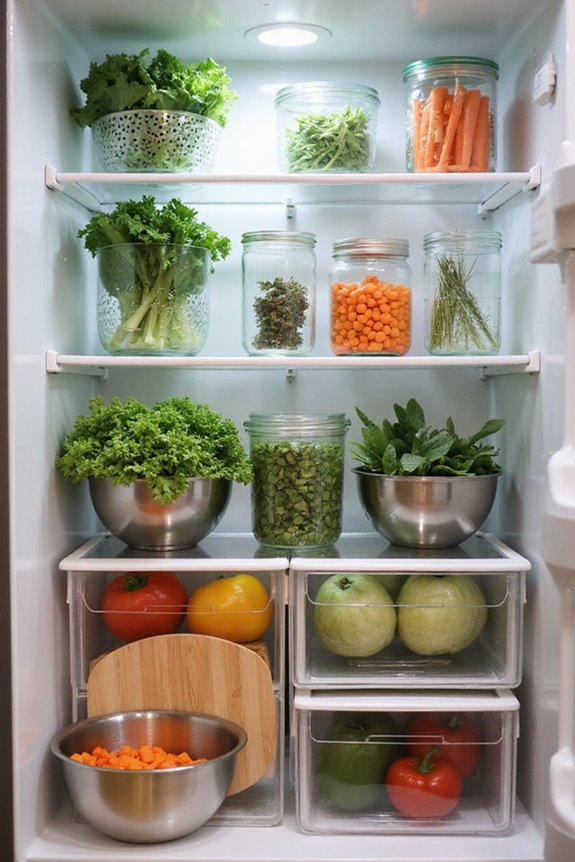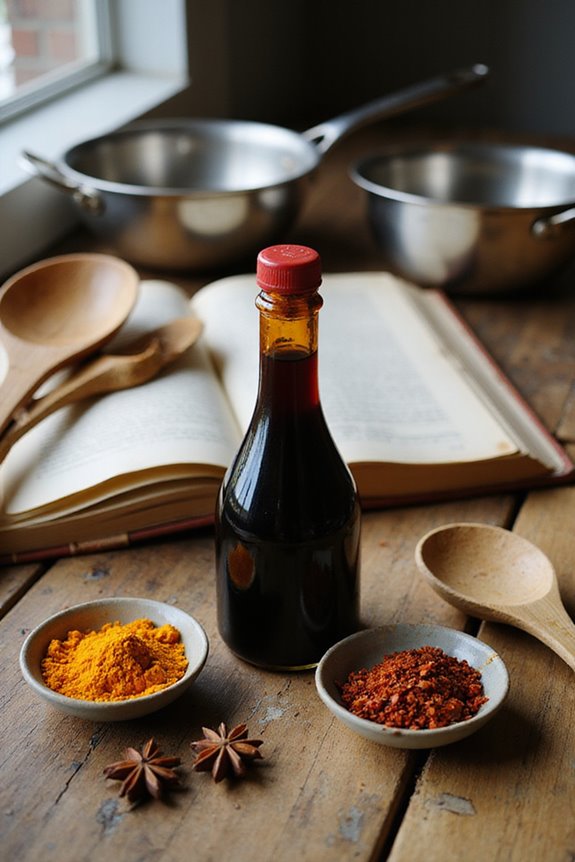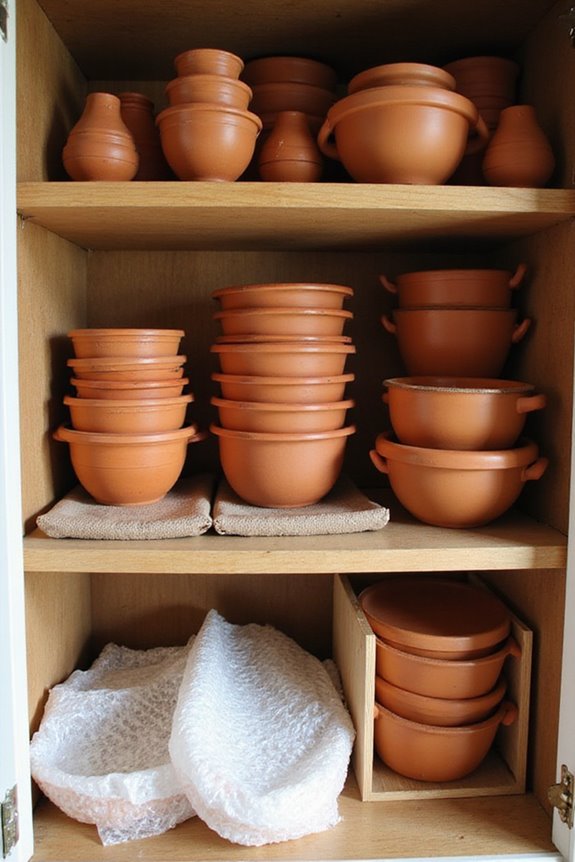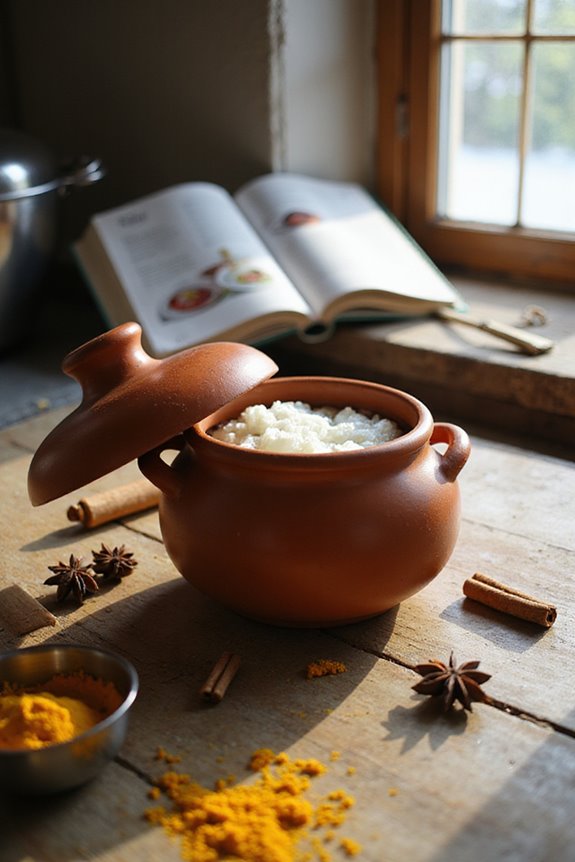Keeping our veggies fresh in the fridge is like giving them a delightful spa day! 🌟 Start with ideal temperatures: cool-season veggies love 32-36°F, while warm-season favorites prefer 50-55°F. Manage humidity, too—high humidity (80-95%) is great for leafy greens, so close those crisper vents! Remember to separate ethylene-producing fruits from sensitive veggies to prevent premature ripening. With these magical tips, we’ll enjoy vibrant, crunchy vegetables for our tasty dishes! Want more secrets to veggie bliss?
Key Takeaways
- Store cool-season veggies at 32-36°F and warm-season crops at 50-55°F to slow respiration and reduce spoilage.
- Maintain high humidity (80-95%) for leafy greens by closing crisper drawer vents, while keeping thick-skinned vegetables in lower humidity (55-60%).
- Avoid washing vegetables before storage; instead, keep them whole and dry to prolong freshness.
- Use airtight containers or specialized produce keepers to manage airflow and humidity effectively while preventing ethylene exposure.
- Store ethylene-sensitive vegetables, like leafy greens, separately from ethylene-producing fruits like apples and bananas to avoid premature ripening.
Understanding Ideal Refrigerator Temperatures
When it comes to keeping our vegetables fresh in the fridge, understanding ideal refrigerator temperatures is absolutely key! The right temperature helps slow down respiration, reducing spoilage and extending shelf life. Here are some quick tips:
- Cool-season veggies (like kale and carrots) love it chilly at 32-36°F.
- Warm-season crops (think tomatoes and peppers) prefer a cozy 50-55°F. Additionally, using essential kitchen tools can further enhance your food storage practices by allowing for efficient organization and improved accessibility of your fresh produce.
Managing Humidity for Optimal Vegetable Storage
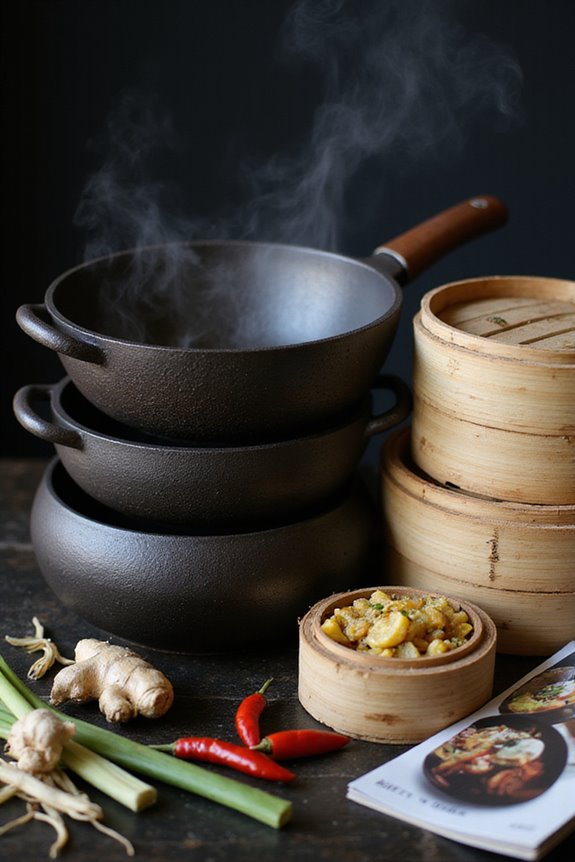
Managing humidity is our secret weapon for keeping veggies fresh and fabulous in the fridge! High humidity (80-95%) is perfect for leafy greens and moisture-loving veggies like broccoli and cucumbers. Let’s close those crisper drawer vents to trap moisture for moisture retention—it’s like gifting our greens a spa day! For thick-skinned veggies like onions and squash, we’ll lower humidity to around 55-60%. Remember, ethylene gas can be sneaky! Keeping ethylene-producing fruits away from sensitive veggies helps maintain that delightful freshness. Additionally, incorporating native plants into your outdoor space can also provide a sustainable source of fresh produce. By optimizing humidity control, we’ll reduce wilting and mold. Happy fridge organizing, everyone! Let’s keep our vegetables vibrant and ready for those magical meal moments!
Preparation Techniques for Prolonged Freshness
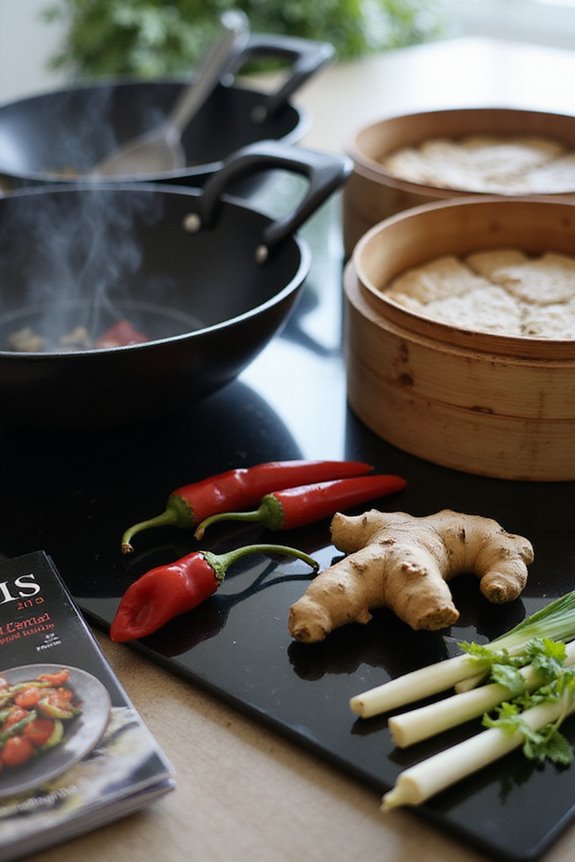
To keep our veggies fresh, let’s plunge into some delightful preparation techniques that’ll enhance their longevity in the fridge. First off, we should avoid those pesky pre-washing risks; wet veggies can spoil faster due to humidity. Instead, let’s store our vegetables whole when possible! Remember to remove roots and stems from root vegetables to maintain freshness.
For a magical touch, dry off any washed veggies thoroughly before putting them away. We’ll also want to practice vegetable separation—storing different types separately keeps moisture and ethylene gas from ruining our treasures. Additionally, using proper water management systems can help maintain optimal humidity levels for your stored vegetables. By handling our veggies with care, we can keep them crisp and vibrant, ready for our next culinary adventure. Happy cooking, everyone!
Choosing the Right Packaging and Containers
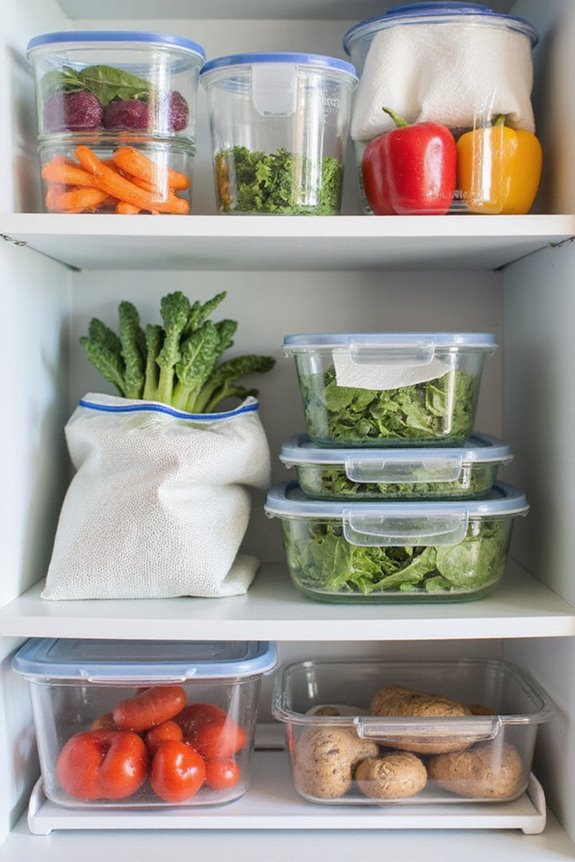
After we’ve mastered those thoughtful preparation techniques, let’s move on to the delightful world of packaging and containers! Choosing the right container materials can make all the difference. Airtight options with silicone seals are magical for keeping veggies fresh. Plus, specialized produce keepers control airflow and humidity, just like a cozy winter cabin!
When it comes to storage shapes, think about your veggies: shallow bins for leafy greens can prevent crushing, while tall containers work wonders for carrots. Don’t forget clear containers for easy visibility—nobody wants to play hide-and-seek with vegetables! Additionally, airtight seals are crucial for maintaining freshness over time.
The Importance of Ethylene Sensitivity
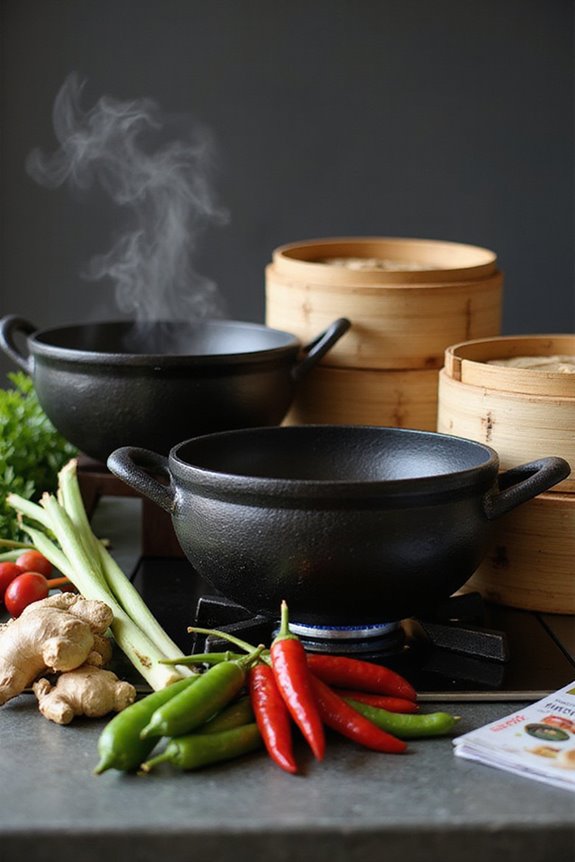
When we consider the delightful nuances of vegetable storage, understanding ethylene sensitivity becomes an essential element in our quest to keep our greens and veggies fresh. Ethylene producers, like apples and bananas, release this magical gas that can lead to premature ripening and spoilage in sensitive vegetables such as broccoli, lettuce, and cauliflower. That’s why we shouldn’t store these together!
To keep our colorful produce at its best:
- Store ethylene-sensitive veggies separately from ethylene producers.
- Choose sealed containers for sensitive items.
- Regularly remove overripe fruits to minimize ethylene gas buildup. Additionally, consider the health benefits of air-fried wings, as proper storage can extend the life of your vegetables and enhance your overall meal prep experience.
Specific Storage Tips for Leafy Greens
Keeping our leafy greens fresh can feel like a magical quest, especially after we’ve learned about ethylene sensitivity! To guarantee delightful leafy green storage, let’s follow a few simple steps:
- Trim and Prep: Remove any brown bits and stems; then tear or cut your greens. This helps prevent moisture buildup!
- Airflow Is Key: Don’t pack greens too tightly—give them room to breathe.
- Moisture Control: Place a paper towel in your storage bag to absorb excess moisture. This little trick stops rot in its tracks!
- Best Storage: Use airtight bags or special produce keepers to maintain humidity.
- Check Regularly: Inspect your greens often, as this can help us avoid spoiling the fun! Additionally, consider using bamboo cutting boards to ensure clean and safe food prep for your veggies.
Let’s keep our greens vibrant and fresh together!
Best Practices for Storing Root Vegetables
Storing root vegetables can feel like starting on a delightful adventure, especially when we grasp the best practices to keep them fresh and fabulous! Here’s how we can master our root vegetable varieties:
- Preparation: Let’s trim tops and excess soil without washing them first! This keeps ‘em from turning into soggy messes.
- Ideal Conditions: Perfect temperatures sit between 32°F and 40°F. A humid environment (90%-95%) is our secret weapon!
- Storage Tips: For beets, an open container with a damp towel works wonders. Carrots love the crisper drawer, while celeriac and parsnips enjoy their own damp towel hugs.
How to Keep Berries Fresh Longer
Berries are like little gems of flavor, bursting with sweetness and color that can brighten any dish! To keep our delightful berries fresh longer, we should pay attention to our berry selection. Opt for plump, firm berries free of mold. For preservation methods, soaking them in a mix of 1 cup of white vinegar and 3 cups of water for 10 minutes work wonders, extending shelf life and preventing mold.
Don’t forget proper storage! Use ventilated containers with paper towels to absorb extra moisture. Wash berries right before enjoying them to maintain that magical freshness. By following these simple steps, we can savor every delicious bite! Let’s keep our berry treasures around as long as possible!
Frequently Asked Questions
Can I Store Vegetables in the Same Crisper Drawer?
Isn’t it fascinating how crisper drawer organization can influence our veggies’ lifespan? We can store some together, but we should separate ethylene-producing fruits to keep everything fresh longer. Let’s guarantee our produce thrives!
How Often Should I Check Fridge Temperatures?
We believe regular fridge maintenance is essential. By monitoring temperature weekly, we can guarantee our food stays fresh longer. A consistent temperature not only safeguards our vegetables but promotes overall food quality and safety, don’t you agree?
Should I Store Vegetables in Glass or Plastic Containers?
When we think about vegetable storage, we’re often torn between glass benefits and plastic drawbacks. Choosing glass keeps our veggies fresher longer and shields them from harmful chemicals, making a healthier choice for all of us.
What Vegetables Should Never Be Refrigerated?
When it comes to vegetables that shouldn’t be refrigerated, we should avoid putting root vegetables and aromatic herbs in the fridge. They thrive best in cool, dry places, enhancing our meals with their flavors and freshness.
How Do I Know if My Vegetables Have Spoiled?
When we think about vegetable storage, we spot signs of spoilage like color changes or a sour smell. Let’s keep an eye out together and guarantee our produce stays fresh and enjoyable for our meals.

